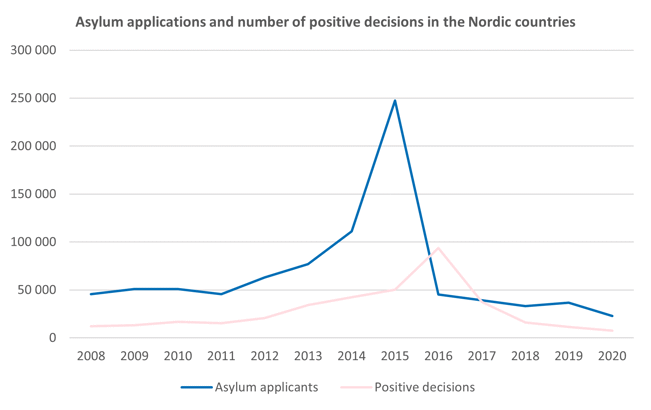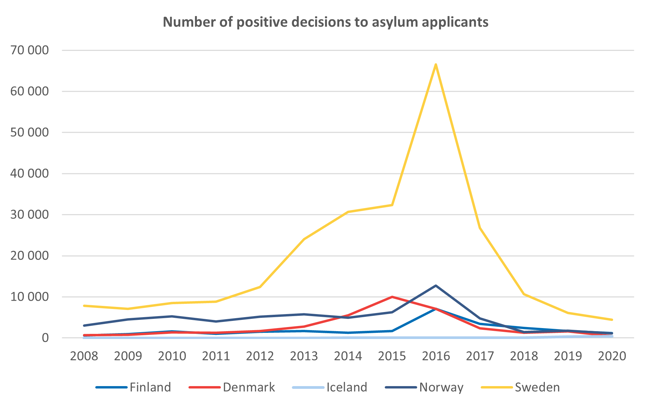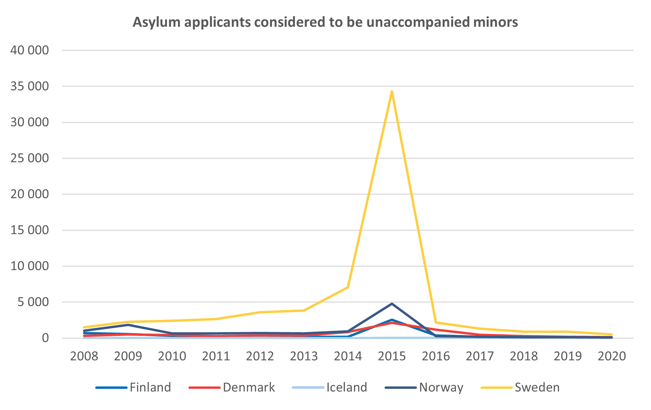Number of asylum applicants to the Nordic region down to pre-peak levels
There have been significant changes in the number of asylum applicants, first instance positive decisions to applications and unaccompanied minors applying for asylum to the Nordic region over the last decade. From 2011 to 2015/2016, the numbers increase drastically, whereafter they decline to levels lower than before the increase. The number of asylum applicants arriving in the Nordic countries peaked in 2015, with almost 250 000 applications. The number of first instance positive decisions on applications then peaked in 2016 with 94 000. In 2020 the numbers were 23 000 and 7 500, respectively.
The subjects of immigration and integration have been debated extensively over the last century. During the wave of refugees around 2015, the public debate was specifically centred around the group of asylum applicants. An asylum applicant is a person who has submitted an application for international protection or has been included in one as a family member. This group only constitutes a smaller part of the total number of migrants in the Nordic countries, but nevertheless take up a prominent position in political discourse.
When the asylum applications in the Nordic countries are added together, there has been significant changes over the last decade. From 2011 to 2015, the numbers increase drastically, but after 2015 they decline to a level lower than before the increase. The number of asylum applicants receiving positive decisions roughly follows the curve of applications. However, the curve is lagged by roughly one year and the numbers are lower – on average just over 40 percent of the number of asylum applications the year before.

Source: Nordic Statistics Database, MIGR04: Asylum applicants and first instance positive decisions on applications by reporting country, citizenship, type and time
The number of asylum applicants arriving in the Nordic countries peaked in 2015, with almost 250 000 applications. The number of first instance positive decisions on applications then peaked in 2016 with 94 000. Analysed by country it can be noted that the peak came earlier in Denmark, they had their highest number of positive decisions in 2015 after a peak in applicants in 2014. The by far highest number of positive decisions in a year can be seen in Sweden in 2016, 67 000. This followed an all time high in applicants to the country in 2015, almost 163 000.
After 2016, the number of positive decisions decreases each year in most of the Nordic countries. In 2020 they are at a level lower than before the peak. Iceland is an exception to this pattern with an increasing number since 2013.

Source: Nordic Statistics Database, MIGR04: Asylum applicants and first instance positive decisions on applications by reporting country, citizenship, type and time
Echoing developments in the number of asylum applications in general, the number of unaccompanied minors arriving in the Nordic countries also peaked in 2015. An unaccompanied minor is defined as an asylum applicant who arrives unaccompanied by an adult.

Source: Nordic Statistics Database, MIGR05: Asylum applicants considered to be unaccompanied minors by reporting country, age, sex and time
A total of 44 000 applications came from this group during 2015, 34 000 of which to Sweden. The unaccompanied minors were predominantly male, and roughly 50 percent were between 16 and 17 years old, but as much as 11 percent were 13 or younger. This distribution by gender and age is about the same during the other years of the period, even though the numbers are significantly lower than in 2015.